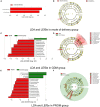Impacts of Delivery Mode and Maternal Factors on Neonatal Oral Microbiota
- PMID: 35832807
- PMCID: PMC9271910
- DOI: 10.3389/fmicb.2022.915423
Impacts of Delivery Mode and Maternal Factors on Neonatal Oral Microbiota
Abstract
Objectives: Initial oral microbial colonization has complicatedly interacted with growth and development. The aim of our study was to discover links between oral microbiota community structure and mode of delivery, maternal factors, such as systemic diseases, abortion history, and pregnancy complications.
Methods: A total of 177 pregnant women and their neonates were enrolled at Peking university people's hospital. We collected oral samples, medical history, and development phenotype and used a 16S rRNA gene sequence to analyze microbial diversity at all taxonomic levels, network structure, and metabolic characteristics.
Results: Firmicutes, Proteobacteria, and Actinobacteriota were the most predominant bacteria of neonatal oral samples among these phyla. Alpha-diversity of pregnant women with gestational diabetes mellitus (GDM), abortion history, and without immune diseases was higher than in control groups, and no significant dissimilarity in beta-diversity was observed between different maternal factors. Obvious separation or trend failed to be seen in different development phenotype groups. Besides, Oscillospirales were significantly more abundant in a natural delivery group than in the cesarean section group.
Conclusion: Our study indicated that maternal factors and mode of delivery influenced the oral microbial structure, but longitudinal studies were indispensable for capturing the long-term effects on neonatal development phenotype and oral microbiota.
Keywords: 16S rRNA gene sequencing; development phenotype; maternal factors; mode of delivery; neonatal oral microbiota.
Copyright © 2022 Xu, Yan, Sun, Xu, Zhang, Zhu, Zhang, Chen, Liu and Chen.
Conflict of interest statement
The authors declare that the research was conducted in the absence of any commercial or financial relationships that could be construed as a potential conflict of interest.
Figures






Similar articles
-
The Initial Oral Microbiota of Neonates Among Subjects With Gestational Diabetes Mellitus.Front Pediatr. 2019 Dec 10;7:513. doi: 10.3389/fped.2019.00513. eCollection 2019. Front Pediatr. 2019. PMID: 31921726 Free PMC article.
-
Dysbiosis of maternal and neonatal microbiota associated with gestational diabetes mellitus.Gut. 2018 Sep;67(9):1614-1625. doi: 10.1136/gutjnl-2018-315988. Epub 2018 May 14. Gut. 2018. PMID: 29760169 Free PMC article.
-
Maturation of the infant microbiome community structure and function across multiple body sites and in relation to mode of delivery.Nat Med. 2017 Mar;23(3):314-326. doi: 10.1038/nm.4272. Epub 2017 Jan 23. Nat Med. 2017. PMID: 28112736 Free PMC article.
-
Influences of gestational diabetes mellitus on the oral microbiota in offspring from birth to 1 month old.BMC Pregnancy Childbirth. 2022 Apr 6;22(1):289. doi: 10.1186/s12884-022-04630-1. BMC Pregnancy Childbirth. 2022. PMID: 35387603 Free PMC article.
-
Screening and diagnosing gestational diabetes mellitus.Evid Rep Technol Assess (Full Rep). 2012 Oct;(210):1-327. Evid Rep Technol Assess (Full Rep). 2012. PMID: 24423035 Free PMC article. Review.
References
LinkOut - more resources
Full Text Sources

